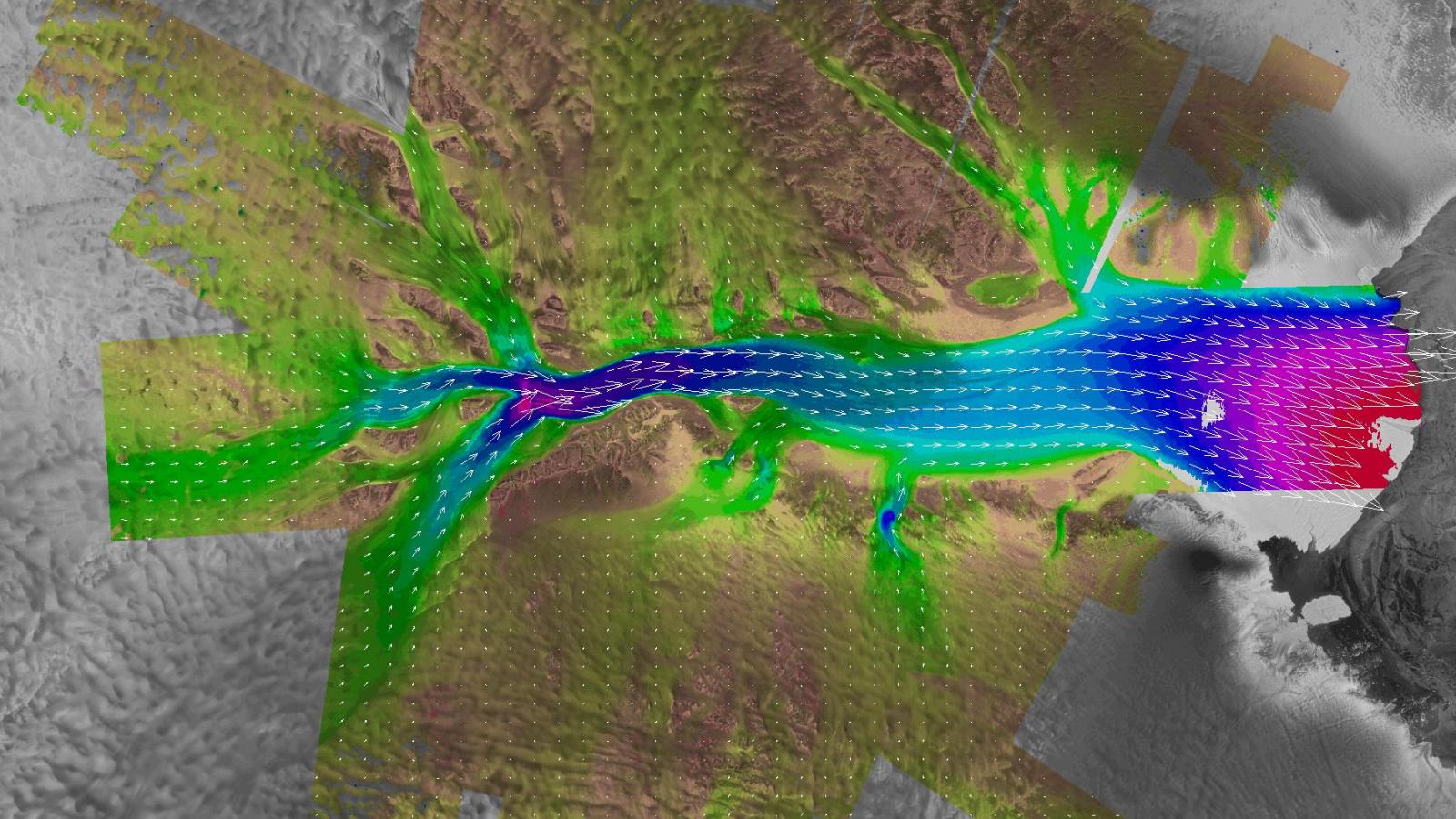Subsequent to the 1997 and 2000 Antarctic Mapping Missions, two other smaller mappings were made in 2004 and again in 2007. Velocity products were generated for the Drygalski Ice Tongue (David Glacier) and the Thwaites and Pine Island Glaciers.
Interferometric pairs are used to compute ice sheet surface velocities during the approximate months of September through December. The methodology and results discussed in this report are provided in partial fulfillment of The Ohio State University's agreement to provide remote sensing data to the Center for Remote Sensing of Ice Sheets (CReSIS) science requirements. CReSIS's vision is to advance understanding of polar ice sheets sufficiently for the development of models that reliably predict future ice sheet contributions to sea level rise under prescribed changes in climate.
Documentation and procedures used to process RADARSAT synthetic aperture radar data were the same used to obtain velocities in for Jakobshavn Glacier, Greenland Document Page.
We have provide the following datasets:
- Velocity ASCII files containing the final derived velocities
- SAR mosaics (100m) in binary, geotif, and ERDAS Imagine formats
- RAMS Final Velocity Products (the individual pieces that went into making the derived ASCII version)
Velocity ASCII Files
- Instructions for creating an ARC shape file and plotting arrows in ARCMap
- 2004 Drygalsky Velocities (X, Y, mag, vx, vy, angles)
- 2007 Drygalsky Velocities (X, Y, mag, vx, vy, angles)
- 2004 Thwaites/Pine Isle Velocities (X, Y, mag, vx, vy, angles)
- 2007 Thwaites/Pine Isle Velocities (X, Y, mag, vx, vy, angles)
SAR mosaics
SAR Mosaics 16-bit binary and header file
- 2004 Drygalsky Mosaic 100m
- 2004 Drygalsky header file
- 2007 Drygalsky Mosaic 100m
- 2007 Drygalsky header file
- 2004 Thwaites/Pine Isle Mosaic 100m
- 2004 Thwaites/Pine Isle header file
- 2007 Thwaites/Pine Isle Mosaic 100m
- 2007 Thwaites/Pine Isle header file
SAR Mosaics GeoTiff and header file
- 2004 Drygalsky Mosaic 100m
- 2004 Drygalsky header file
- 2007 Drygalsky Mosaic 100m
- 2007 Drygalsky header file
- 2004 Thwaites/Pine Isle Mosaic 100m
- 2004 Thwaites/Pine Isle header file
- 2007 Thwaites/Pine Isle Mosaic 100m
- 2007 Thwaites/Pine Isle header file
SAR Mosaics ERDAS Imagine format (with rrd file)
- 2004 Drygalsky Mosaic 100m
- 2004 Drygalsky rrd file
- 2007 Drygalsky Mosaic 100m
- 2007 Drygalsky rrd file
- 2004 Thwaites/Pine Isle Mosaic 100m
- 2004 Thwaites/Pine Isle rrd file
- 2007 Thwaites/Pine Isle Mosaic 100m
- 2007 Thwaites/Pine Isle rrd file
RAMS Final Velocity Product Document
Even though the Drygalsky Ice Tongue is in more of a steady state of flow, we used ever increasing search radiuses working our way from the interior (slow flow, small search radius) to the coastal area (faster, larger search radius). Very little editing was done on the Drygalsky results prior to concatenation into a final product (click on "1) Velocity ASCII files" link above).
In order to capture the diverse velocity field of the Thwaites and Pine Island Glaciers (years 2004 and 2007) multiple sets of RAMS Vphase parameters had to be used, resulting in multiple sets of overviews (ov_## files listed below). Each overview was edited for any erroneous velocity vectors and concatenated into a final product (click on "1) Velocity ASCII files" link above).
A detailed description of all the RAMS VphaseTool Phase I parameters (registration and creation of interferograms) was provided by the Vexcel Corporation, the developers of RAMS, and is available in addendum III of the BPRC Tech Report BPRC Tech Report
In the creation of the interferograms, the three prominent parameters used for estimating a range of velocities are the 1) lower coherence threshold, 2) offset chip size and 3) offset search radius, all other default parameters were used. A description of the 'optimum' search radius and chip sizes is included below ('Optimal Search Radius and Chip Size' link).
README File
Readme file associated with each *.tar file. Please read to familiarize yourself with the contents of each file.
Location of the Thwaites and Pine Island overviews (ov_*) for years 2004 and 2007 Shows the location of each of the ov* files that made up the concatenated Final Velocity ASCII file (if more than one).
Optimal Search Radius and Chip Size
Note: A chart of Search Radius and Chip Size parameter for individual overviews is forthcoming.

